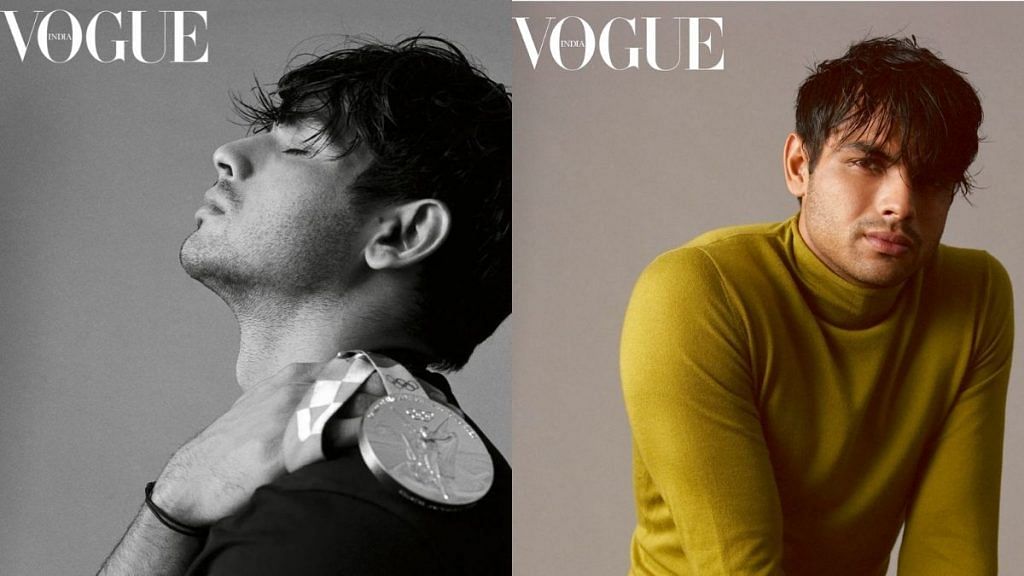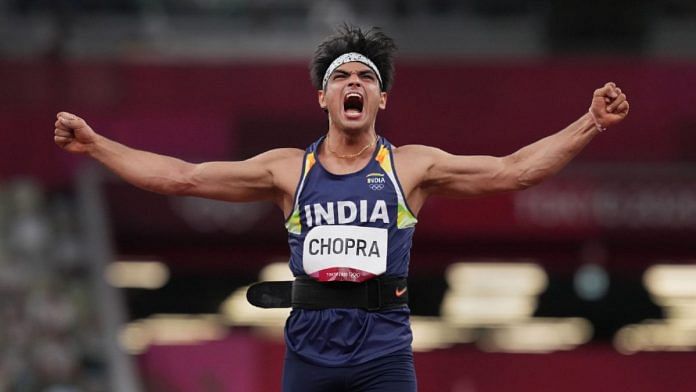A lesser-known man and an even-lesser known sport made headlines on 7 August 2021 when Neeraj Chopra won the Tokyo Olympics gold for India in javelin throw. The 23-year-old became an instant celebrity, household name and inspiration for bringing to limelight a sport that wasn’t boxing, hockey or cricket. India’s track record in track-and-field had been less than impressive, to say the least.
Now Neeraj Chopra has broken the glamour glass ceiling by being the first male athlete to adorn the cover of Vogue India, and also the first non-cricketing athlete to put the nation in a tizzy through his very commendable acting skills.

Post-Olympic stardom
The world number 2 in javelin was everywhere soon, from billboards to a very well-received and well-performed CRED ad. He was also saying the right sportsman things, not giving into jingoism. And to say everyone lost it would be a mild understatement. Chopra became the pin-up boy created by Indian women and media. In an interview with Times Now, Navika Kumar asked him what she thought was the most important question plaguing Indian women since Virat Kohli got married to Anushka Sharma—is Neeraj Chopra single and ready to mingle?
“I only want to focus on my game right now,” the Olympic champion replied.
View this post on Instagram
Did it stop at that? Well, no. Malishka Mendonsa, popularly known as RJ Malishka of Red FM Mumbai, shared a video of her dancing with her colleagues before recording an interview with Neeraj Chopra. With roses in hand, the women staff were seen grooving to ‘Udein jab jab zulfein teri’. Malishka also wanted to give Neeraj ‘Jhadoo ki jhappi’.
But it’s the effortless Vogue cover and interview that has made Neeraj Chopra a glamour icon.
Also read: 71% Indian parents game if child chooses sport other than cricket as a career, survey says
In Vogue
Styled by Priyanka Kapadia and shot by Bikramjit Bose, Chopra wore a high-neck, white sweater and black trousers on the cover. This is the very first time that Vogue India has featured a male athlete on its cover, and, surprisingly, it’s not a cricketer.
Neeraj Chopra’s look is refreshing because it does not play on his physique, but what he has come to represent — the chocolate boy image, the pin-up star and a performer. It’s effortless, stylish, and does not give in to macho stereotypes.
“It’s not that my Olympic medal is everything and so I don’t need to do more,” he says, not taking the fame for granted.
View this post on Instagram
He is understated yet fashionable, with messy, unkempt hair. Each look focuses on him, rather than his body as an athlete or the kind of voyeurism that a lot of magazine covers cater to when it comes to male celebrity shoots.
I mean, it was not a big surprise that he was the ‘chosen One’. The hysteria is real, both about Neeraj Chopra the Olympic gold medallist, and Neeraj Chopra, the good-looking guy.
A line in Chopra’s feature on Vogue stands out particularly — “In an eight-and-a-half foot, 800gm streamlined carbon fibre flying object, Chopra has found a version of himself that no one would have dreamt of”. It is, after all, exactly this that makes Chopra more than just a heartthrob—he is not separate from his javelin. It is not a prop for him on shoot. It is the sport that defines him, and he sticks by it.
“Javelin ke bina,” he says, “mujhe lagta hai Neeraj hai hi nahin.”
Also read: 6 medals in 4 Games: How India’s Olympic run has changed wrestling in Haryana
Another star, another sport
In 2008, another man managed to capture the limelight for his breakthrough performance in the Summer Olympics that year—boxer Vijender Singh who won the bronze for India. In recognition of his success, in 2009, Singh was named the top-ranked boxer in the International Boxing Association’s annual middle-weight category list. He soon adorned magazine covers, and even landed himself a Bollywood film—Fugly in 2014—alongside Jimmy Sheirgill, Kiara Ali Advani and others.
Vijender Singh’s win and eventual foray into modelling also did what the Neeraj Chopra fever is doing right now for javelin—bring boxing to the fore, make it glamorous enough for sponsors, and people in general to sit up and take notice. Of course, Singh’s looks and modelling helped that to a large extent. He was on The Man and Man’s World cover. Vijender too never shied away from acknowledging it.
The boxer in a 2008 interview with The Indian Express asserted, “I want to use this platform (modelling) to bring the game in the limelight, make it as popular as possible and catapult it to its deserving place at the top.”
Did he do it? Well, popularity of boxing has definitely picked up, both through terrific performances by Indian boxers and also representation, be it the Mary Kom biopic that starred a global star like Priyanka Chopra, Aamir Khan’s Dangal, Salman Khan’s Sultan, or even the number of medals won at the recent Tokyo Olympics.
And as for Neeraj Chopra, he is what track-and-field in India was probably waiting for. The Athletics Federation of India announced that each state unit will hold an annual javelin competition every 7 August, the day Chopra won Olympics gold. People are seriously thinking about picking up the javelin.
Why do we need someone like Neeraj Chopra or Vijender Singh to propel ‘obscure’ sports into limelight? Because glamour has been a big part of athletics in India, whether or not we want to accept it. Cricket has managed to keep at it, be it due to celebrity weddings, ads or even biopics. Not many remember or know, but India won a gold in Paralympics in javelin in 2004 as then 23-year-old Devendra Jhajharia began a hat trick that he completed in the Tokyo Paralympics with this third gold in the sport. But it took Neeraj Chopra and a country’s obsession and ‘fangirling’ to make the wheels turn.
From Face Magazine to The Man and now Vogue, Neeraj is ensuring children who have sports dreams and not many options to choose from can get a chance to dream big, and be a star and a sportsman both.
Views are personal.



